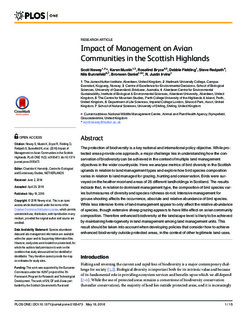Impact of Management on Avian Communities in the Scottish Highlands
Newey, Scott; Mustin, Karen; Bryce, Rosalind; Fielding, Debbie; Redpath, Steve; Bunnefeld, Nils; Daniel, Bronwen; Irvine, R. Justin
Journal article, Peer reviewed
Permanent lenke
http://hdl.handle.net/11250/2427518Utgivelsesdato
2016Metadata
Vis full innførselSamlinger
Originalversjon
10.1371/ journal.pone.0155473Sammendrag
The protection of biodiversity is a key national and international policy objective. While pro-
tected areas provide one approach, a major challenge lies in understanding how the con-
servation of biodiversity can be achieved in the context of multiple land management
objectives in the wider countryside. Here we analyse metrics of bird diversity in the Scottish
uplands in relation to land management types and explore how bird species composition
varies in relation to land managed for grazing, hunting and conservation. Birds were sur-
veyed on the heather moorland areas of 26 different landholdings in Scotland. The results
indicate that, in relation to dominant management type, the composition of bird species var-
ies but measures of diversity and species richness do not. Intensive management for
grouse shooting affects the occurrence, absolute and relative abundance of bird species.
While less intensive forms of land management appear to only affect the relative abundance
of species, though extensive sheep grazing appears to have little effect on avian community
composition. Therefore enhanced biodiversity at the landscape level is likely to be achieved
by maintaining heterogeneity in land management among land management units. This
result should be taken into account when developing policies that consider how to achieve
enhanced biodiversity outside protected areas, in the context of other legitimate land-uses
